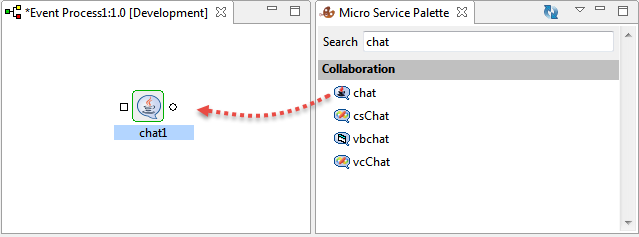Adding Microservices
To add microservices, perform the steps below:
Open the Micro Service Palette and click the Category tab corresponding to the microservice.
- Drag the business component icon onto the Fiorano Orchestrator editor.

Figure 1: Adding a microservice to the Event Process Orchestrator editor
Each icon in the Fiorano Orchestrator editor represents an instance of the microservice. By default, the name of each instance of the microservice is the service GUID followed by the instance ID count (such as chat1 in the figure above).
Connecting Routes
For the data to flow between two microservice instances, they need to be linked via Event Routes. The Route represents the Brokered Peer-to-Peer data Route. The Event Routes are unidirectional and always originate at output Event Port of the source microservice and end at input Event Port of the target microservice.
Connect the Route from the output channel (OUT_PORT) of the Chat1 microservice icon to the input channel (IN_PORT) of the Chat2 microservice icon and vice versa, as shown in the figure below. By default, each Route is identified by an Event Route name such as Route1 and Route2. The suffix represents the instance count of the Route.

Figure 2: Connecting microservices through routes